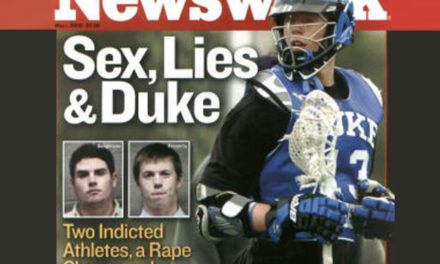Rich Kids Get Away With Murder
On the evening of August 20, 1989 Lyle Menendez, sobbing, called 911. “Somebody killed my parents,” he said. Lyle was 21 then, three years older than his brother Erik. When the police arrived Lyle was curled in a fetal position on the front lawn still hysterically crying.
Earlier that evening their parents, Jose and Mary “Kitty” Menendez, were relaxing in the den of their Beverly Hills mansion. They were apparently attacked while sitting on the couch, eating strawberry ice cream and watching a movie on T.V. Jose was shot multiple times in the head and was virtually decapitated. They both were shot behind the knees as well, adding an interesting clue to the psychological dimension of the crime.
Mary tried to run a short way down the hallway. She was shot in the leg and was believed to be crawling down the hall when she was shot multiple times in the face with a 12-gauge shotgun. She was unrecognizable.
When officers from the police department arrived, the brothers told them they had been out, at a movie theater, seeing Batman. Then they went to the annual “Taste of LA” festival in Santa Monica. The brothers drove straight home, found the bodies of their parents and Lyle made his hysterical call for help.
Initially, no evidence pointed at the sons. The brothers weren’t under suspicion and didn’t have to undergo gunshot residue tests in order to see if they had recently used a firearm. When questioned by the police the brothers said they believed it was an organized crime killing. The signature “knee-capping” used by the mob suggested the boys might be right.
In the months following the murders, the brothers attracted unwelcome police attention by spending lavishly. Lyle bought a Rolex watch, a Porsche Carrera and a popular student restaurant he turned into a buffalo chicken wing joint in Princeton, New Jersey. Erik bought a Jeep, hired a full-time tennis coach and competed in tournaments in Israel. Together they cruised Los Angeles in their late mother’s Mercedes-Benz convertible, dined in upscale restaurants and went on trips to the Caribbean and London. They left their parents’ mansion and got his-and-his luxury condos. By some estimates they spent around $700,000 during those months. (Interestingly, some family members said, in their defense, there were actually no changes in their spending habits before and after the killings.)
The police narrowed their search to those who might have motives to kill Jose and Kitty, such as known mobsters and a porn dealer that Jose had difficulties with in the past. Nothing came of their leads. As the investigation went on they began, again, to look more closely at the brothers.
The Menendez brothers were in line to inherit their parents’ entire estate plus $500,000 in life insurance. The investigation revealed the brothers had overheard that their father had plans to change his will, disinheriting them. A revised will wasn’t found but Erik was said to have been trying to find it on his father’s computer, and hired someone to hack the device.
As it stood Erik and Lyle would be receiving the inheritance as set out in Jose’s unrevised will, the only one found among his papers. To the police that sufficed as a strong motive and they came up with a plan– entrapment.
Attempting to get a confession from Erik, the police convinced one of his friends, Craig Cignarelli, to wear a wire. Craig, an old classmate from high school and a sometime tennis partner, asked Erik to lunch at a beachfront restaurant. Craig led the conversation around to the murder. He asked Erik if he had killed his parents. Erik said no. Case closed!
THE TRUTH WILL COME OUT
But Erik’s psyche seemed to be shaky. He was getting an ulcer, having a harder time than his more jubilant, more free-spending brother. Eventually, in confidence, to his psychologist Jerome Oziel, Erik confessed to the murder. Lyle also was seeing Jerome and was taped admitting to the crime.
The brothers said they had done it to “put their mother out of her misery.” They said they killed their father to punish him for his many infidelities.
Breaking patient confidentiality, which would later create legal issues, Jerome told his mistress, Judalon Smyth, about Erik’s confession. Jerome and Judalon had a troubled relationship and he was said to be physically abusive. After Judalon broke up with Jerome, she went to the police and spilled the beans. She even had a copy of his clients’ tapes.
Lyle was arrested March 8, 1990 when Erik was in Israel competing in a tennis tournament.. Erik turned himself in three days later upon his return to Los Angeles. They were held without bail and separated.
What the brothers said they did the night of the murder, the movie and the festival, was all true, sort of. The part they didn’t mention was a stop they made on the way. Leaving the carnage at their parent’s house Erik and Lyle drove up to Mulholland Drive and dumped their shotguns. They discarded their bloody clothing and even went back home to change. Then they bought movie tickets to provide their alibis. But they didn’t see Batman.
RICH BUT NOT FAMOUS… UNTIL THEIR MURDER
The trials of the two brothers in 1990 were a national sensation, firing the imaginations of the American public and generating astounding media coverage. Wealth, murder and greed was a winning formula.The Menendez brothers had become a type, iconic preppies.
–Kaitlin Menza, TOWN AND COUNTRY magazine, Sept. 26, 2017
The wealth of the parents and the greed of their children were major topics of discussion on the street and in the office. Jose and Kitty’s grisly deaths made big headlines trumpeting their wealth as motive for killing them. The story was that these rich kids had been spoiled rotten and, not satisfied with a lavish lifestyle, wanted their parents’ whole fortune. Rich wasn’t enough. The kids wanted their big, fat inheritance. So they killed Mom and Dad. It played well on the nightly news.
Jose had been born into a life of wealth and privilege in Cuba’s high society. Jose’s family encouraged a “macho,” aggressive attitude in him from an early age. He was known to his neighbors as a bully and a “monster.”
Then, when he was 16, the Communist revolution created turmoil in his home country, so his family sent him to the United States for his safety. He was no longer one of the rich or the powerful.
After he graduated high school, he was accepted into Southern Illinois University. There he met Mary Louise “Kitty” Andersen, a beauty queen with dreams of becoming an actress. The two were wed in 1963 and moved to New York City, where Kitty taught school while José earned his degree in accounting at Queens College. He worked as a dishwasher. They were poor. They worked hard and slowly they made more and more money. Together they worked to achieve the American Dream.
In the end, José Menendez was famous more for the circumstances of his death than for any of his achievements in life.
Until they were murdered by their two sons, Beverly Hills millionaires Jose and Kitty Menendez had no real status in the entertainment world they only skirted the edges of, and in which they were not considered really, truly wealthy.
Jose, an executive at Live Entertainment, a video-distribution company, made a half-million a year plus a hefty $850,000 bonus. But in the entertainment industry, and Beverly Hills, their estimated net worth of 14.5 million barely made the Menendez family upper middle class. As was usual among their social set, the couple was also heavily mortgaged and living beyond their means. They had two dissatisfied sons who went to, and got kicked out of, the best schools.
Lyle was known for becoming furious when he was given an inadequate car, not the Porsche he bought to replace it right after he killed his parents. Both boys had police records for burglary and theft–they lacked for nothing, but they stole. The boys lived high compared to most of their friends, even those whose parents were genuinely wealthy. The possibility of being disinherited was disturbing.
With that information it would seem the Menendez brothers were simply being practical. They did need more money for the lives they wanted to live. They did want more than their parents could provide while living.
Some, but not all, of the money they took from the family accounts prior to their conviction for murder (which would deny them all future inheritance) was spent on un-fun stuff.
Four million was used in estate taxes. Nearly one and a half million was used to settle their legal bills. Four point two million was used in mortgage payments. Ten point eight million was used for little extras.
TRIALS AND ERRORS
Their father was nearly decapitated by the 12-gauge shotgun used in the attack and their mother was also rendered almost unrecognizable after being shot several times, the Los Angeles Times reported in 1990.
The trial was also minutely covered by reporter/novelist Dominick Dunne for Vanity Fair in October, 1990.
NIGHTMARE ON ELM DRIVE
The trial was stalled. Portions of the tapes of the brothers’ sessions with their therapist were ruled admissible by a judge, which their attorney appealed. Resolving the issue of the tapes took 30 months coming to a close when the Supreme Court of California intervened. Indicted on December 7, 1992, the brothers were tried separately for murder. The case took seven years before coming to a close.
In Erik’s case the jury deadlocked. Then the jury in Lyle’s case deadlocked soon after. Mistrials were declared in both cases. Finally on April 17, 1996, a third, final jury trying both brothers together found them both guilty.
The first cases ended in mistrials because of a surprising new argument from the defense. Erik and Lyle had a reason for murder. They had both been molested by their father since childhood.
According to the brothers both parents had abused them. The mother, zoned out on pills and liquor, didn’t protect them from their father who raped them. Presented by Defense Attorney Leslie Abramson, it was offered up as a possible reason, potentially a justifiable reason, for retribution.
The brothers claimed that they feared their father would kill them if they told he had molested them. Jose was described as “a cruel perfectionist,” a bully, and a pedophile .
For the second trial, they were tried together by a single jury. Their story of parental abuse as an excuse didn’t play well with judge or jury in the 1990s. The story was impossible to corroborate because they hadn’t made documented complaints of the abuse at the time. By the time the brothers brought up this sordid history, the public had been thinking of wealth and greed and spoiled rich boys for years.
Despite there being no new developments in the case in 25 years, the story of the Menéndez brothers has found an unlikely new audience thanks to the social media app, TikTok.
Pages in support of Lyle and Erik Menendez on social media have been robust, particularly on TikTok and Instagram, according to The New York Times. During the coronavirus pandemic, young people started binge-watching the trial, which has generated not only interest among those not even born at the time of the crimes, but also “sympathy” for the brothers, the Times explained.
The video-sharing service popular among younger generations has seen an influx of content surrounding the brothers in recent months, with much of it calling for Lyle and Erik to be tried again – or even released.
It’s all boils down to one issue– the prolonged sexual abuse they claimed to have endured in their testimonies, the abuse that led to their decision to kill their parents.
Videos on TikTok that show the moment the brothers testified in court, baring visible pain as they remembered traumatic occurrences, have captured the attention of a mostly teen audience, growing up in an age where attitudes are very much different to those some 30 years ago.
Now, the trend is to view sexual abuse to be a life-changing and horrifying ordeal. While we also know there are probably much more constructive ways of dealing with that pain than killing those responsible, the empathetic user base of TikTok roots for the brothers.
The entire trial of the brothers is available to view online, and with users having poured through the footage, they’ve come to some startling conclusions of their own.
In a report for ABC News, Erin Murtha detailed how she looked into the driving forces behind the phenomenon, and was met with an army of teens with an “astounding” amount of knowledge “they had accumulated about a legally complex case.
“None of these teenagers deny that this horrific crime of their parents being murdered happened or that it was Erik and Lyle who committed it, Rather – they take an empathetic approach supported by the benefits of hindsight.
They’re now looking at the murders through the lens of the values of 2021 – especially with regard to the claims of sexual abuse… they have grown up in an era where #MeToo reigns and where people can speak more openly about what were previously deemed to be uncomfortable issues.”
— Erin Murtha date xx, ABC News
Videos on the subject regularly garner millions of views and shares, and in a world where social media movements and activism can help drive real world change, could the Menéndez brothers be given another shot?
It may be unlikely, but at the very least, the tale of a decades old case getting new attention on social media is an interesting one – what other historical crimes will Gen Z sleuths demand be given a second look in the future.



